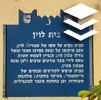The sign shape is rectangle but its head is designed according to the silhouette of the old building of the Gymnasia Herzliya, which serves as a logo of the Council for the Preservation of Heritage Sites in Israel
The yard was photographed on the day the sign was taken
 Click for a larger image
Click for a larger image The synagogue mentioned on the sign as designed by Daniel Lifshitz is immortalized on a separate sign
 Click for sign's details Translation of the text on the sign
Click for sign's details Translation of the text on the sign:
Symbol of the Council for the Preservation of Israeli Heritage Sites
The emblem of the city of Petah Tikva
Yard of Daniel Lifshitz Daniel Lifshitz, nicknamed "Dana", was one of the first Bialystok settlers to join the people of Petah Tikva in Judea in 1883 and later immigrated to settle in the colony.
He was a renowned engineer and a man with knowledge in many fields.
Among the important buildings he designed in the colony was the Great Synagogue located further down Hovevei Zion Street.
The Lifshitz family raised larvae for the silk industry, and in the basement of the building that stood in the farm yard, the larvae were raised and kept.
Citrus trees, vineyards and almond groves were also planted.
The complex included a building facing the front of the street, with an arch that supported the building and was used beyond the large courtyard. This arch is the only one of its kind in the courtyards of the peasants of the Judean colonies, left over from the period of the first aliyah.
In the courtyard stands another two-story building, built of kurkar stones. This building was built as an orphanage but served as a hotel and its rooms were rented to the homeless in the colony.

 Click for a larger image
Click for a larger image  Click for sign's details
Click for sign's details  Click for all signs belonging to Heritage Sites in Israel
Click for all signs belonging to Heritage Sites in Israel
 92 Meter |
92 Meter |  110 Meter |
110 Meter |  140 Meter |
140 Meter |  142 Meter |
142 Meter |  161 Meter
161 Meter